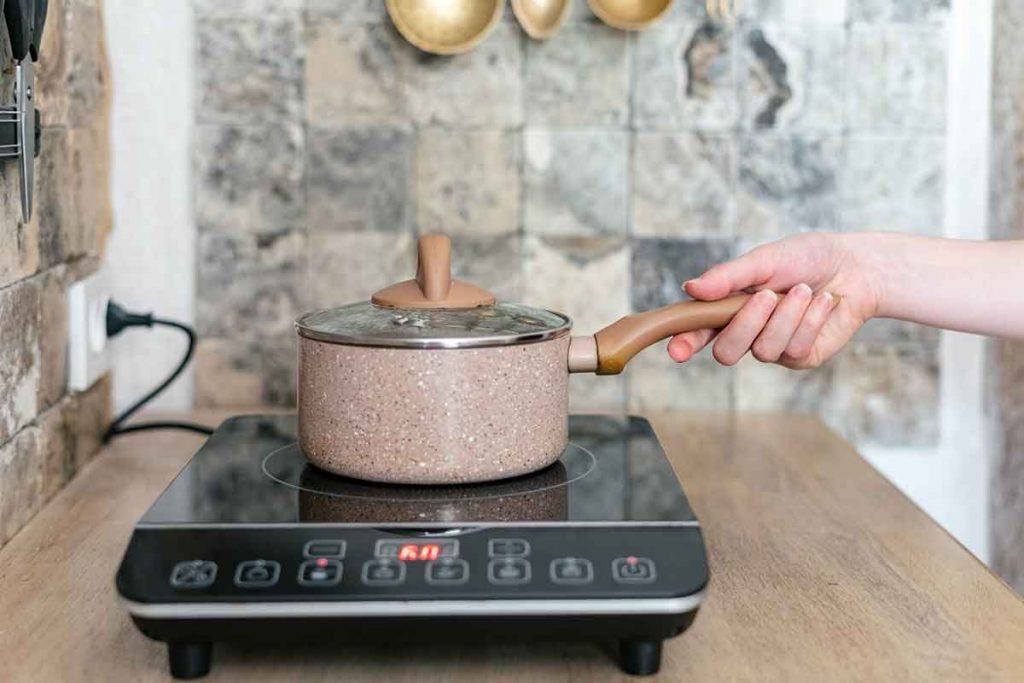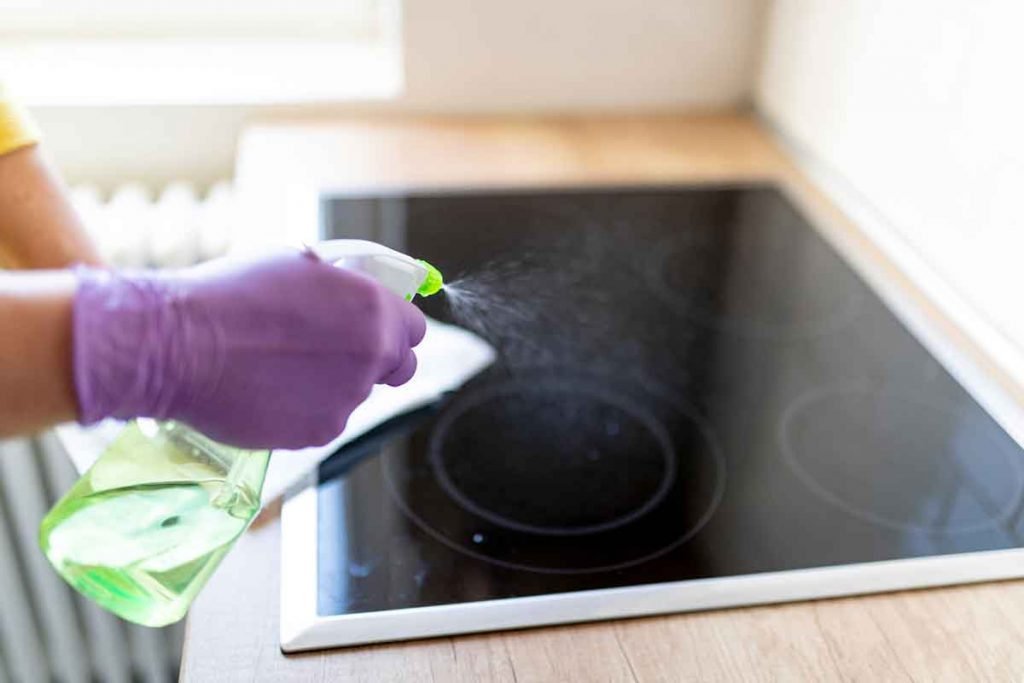Little risk of your food overcooking, less or no manual intervention adjusting power output for your induction hob, and world-class cooking. A dream, right? Is an induction cooktop designed to do all that? Does an induction cooktop keep a constant temperature, you ask?
The short answer is Yes, an induction cooktop can keep a constant temperature.
You see, Temperature stability is crucial for achieving consistent and precise results with all your recipes. This article looks at the workings of induction cooktops to understand how they regulate and maintain temperatures, as well as a table to show you what’s the perfect temperature for your foods.
Let’s get to it, shall we?
Do Induction Cooktops Maintain Constant Heat?
Yes, induction cooktops, especially the latest models, are designed to maintain constant heat thanks to their precise temperature control, even heating, and advanced technology. Whether you’re sautéing, simmering, or boiling, induction cooktops offer an efficient and accurate cooking experience.
So, how do they do it?
- Induction cooktops utilize advanced technology that sets them apart from traditional gas or electric stoves. Instead of relying on open flames or radiant elements, induction cooktops employ electromagnetic induction to directly heat the cookware.
- One of the primary advantages of induction cooktops is their ability to provide precise temperature control. They respond quickly to adjustments, allowing you to change temperatures instantly with the touch of a button. Most induction cooktops offer a wide range of temperature settings, from low simmering temperatures to high heat for rapid boiling.
- Induction cooktops are known to maintain consistency and even heat across the cooking surface. The electromagnetic field ensures that the entire bottom of the cookware receives uniform heat distribution. This feature is especially useful for recipes that require precise heat control, such as delicate sauces, tempering chocolate, or simmering stews.
- Modern induction cooktops are equipped with temperature sensors that monitor and regulate the cooking temperature. These sensors continually adjust the power output to ensure the desired temperature is maintained. If the cookware’s temperature deviates from the set level, the cooktop automatically adjusts the power to bring it back to the desired heat.
- Some advanced induction cooktops also offer boil-over prevention features. By sensing the formation of bubbles, the cooktop will automatically lower the heat output, preventing messy boil-overs and ensuring a safer cooking experience.
- Induction cooktops come with various safety features, including automatic shut-off timers. These timers can turn off the heat after a specified period, giving you some peace of mind when cooking your meals.
Do Induction Stoves Turn Themselves Off if They Get Too Hot?
Yes, many modern induction stoves are equipped with safety features that automatically turn themselves off if they get too hot. These safety features are designed to prevent overheating and damage to the cooktop or surrounding materials.
One common safety feature found in induction stoves is the thermal sensor. This sensor continuously monitors the temperature of the cooktop’s surface. If it detects that the surface is getting too hot, it will automatically shut off the power to the heating elements, effectively turning off the stove.
You’ll also find some induction stoves with a built-in timer that can be set to automatically turn off the stove after a certain period of cooking time. Make sure that you read the user manual and understand the specific safety features and functionalities of your induction stove to ensure safe and proper use.
What Happens if You Forget to Turn off the Induction Stove?
If you forget to turn off an induction stove, it will likely remain in its current state, keeping the last settings you used. The cooktop will continue to generate heat as long as the power is left on, and the cooking zone is active. This can lead to:
- Overcooking or Burning food – If there is a pot or pan in the cooking zone with food inside, it may continue to cook or even burn if left unattended for an extended period.
- Wasted Energy – Leaving the induction stove on without any cooking vessel in the cooking zone will waste electricity and contribute to higher energy bills.
- Safety hazards – Although induction cooktops are designed to be safer than electric stoves, leaving them unattended for too long can still pose safety risks. For example, if flammable items or objects are left near the cooktop, they could accidentally come into contact with the heated surface.
- Damage to the stovetop – Extended use of the induction stove without any cookware in the cooking zone can lead to overheating and may damage the cooktop.
Is an Induction Cooktop Supposed to Heat with Pauses?
Yes, it is normal for an induction cooktop to heat with pauses. Induction cooktops use electromagnetic fields to transfer heat directly to the cookware, which then heats the food inside. The heating process involves a cycle of turning the power on and off to control the amount of heat being generated.
How, here’s how it works.
The cooktop’s sensors detect the temperature of the cookware and adjust the power output accordingly. When it reaches the temperature, it reduces the power temporarily, and then it resumes when the temperature drops slightly. This cycle continues to maintain a consistent cooking temperature.
Heating with pauses is a normal behavior of induction cooktops and is important for precise and efficient cooking. It allows for precise temperature control, preventing the cookware from overheating and ensuring even cooking results. It also contributes to energy efficiency by using only the necessary amount of power to maintain the desired cooking temperature.
What are the Different Temperature Levels for Different Foods? Induction Stove Top Temperature Table
Understanding the appropriate induction temperature levels for cooking is important to mastering your cooking. Induction cooktops typically offer a specific temperature range, usually spanning from 38 degrees Celsius to 260 degrees Celsius (100 degrees Fahrenheit to 500 degrees Fahrenheit).
While induction cooktops are known for their powerful performance, extremely high heat settings are rarely necessary for everyday cooking. However, when it comes to tasks like rapid boiling of large quantities, higher temperature settings are indeed beneficial.
Here’s a temperature table for inductions cooktop you can always refer to:
Induction Cooktop Temperature Settings
| No. | Temperature Setting | Temperature Value | Cooking Function |
|---|---|---|---|
| 1 | Warm – Low | 100°F (37°C) | Used for keeping food warm in winters |
| 2 | Warm – Low | 110°F (43°C) | Used for melting foods like chocolate, frozen food etc. |
| 3 | Low | 150°F (65°C) | Ideal for slow cooking most foods |
| 4 | Medium-Low | 180°F (82°C) | Ideal for sauces, soups, and chicken stocks |
| 5 | Medium-Low | 210°F (99°C) | Ideal for steaming vegetables until tender |
| 6 | Medium | 240°F (116°C) | Ideal for roasting or grilling chicken, frying eggs (sunny side up) |
| 7 | Medium | 270°F (132°C) | Ideal for cooking noodles and pasta |
| 8 | Medium-High | 300°F (150°C) | For rendering or caramelizing, making pancakes |
| 9 | Medium-High | 360°F (182°C) | For making crispy chicken fry, sauteing, making grilled cheese sandwich, browning after a sear |
| 10 | High | 390°F (199°C) | For frying meat, cutlets, and fritters, making popcorn |
| 11 | High | 420°F (216°C) | For pan-frying pork chops, mutton chops, chicken, caramelizing, stir-frying shrimps, large cut veggies |
| 12 | High | 450°F (232°C) | For quick searing of marinated chicken, charring meat and vegetables |
| 13 | Max-Sear | 575°F (302°C) | For developing crust on vegetables and meat, crisping skin |
Induction Cooktops Temperature Frequently Asked Questions (FAQs)
Do Induction Cooktops Heat Evenly?
Yes, induction cooktops heat evenly across the cooking surface. Unlike traditional gas or electric stoves that rely on radiant heat or open flames, induction cooktops use electromagnetic induction to directly heat the cookware. The entire bottom of the cookware receives uniform heat distribution, ensuring that food cooks evenly and consistently.
The magnetic field created by the induction cooktop transfers energy directly to the base of the cookware. As a result, there are no hotspots or cold spots on the cooking surface, which can be common with other cooking methods. Whether you are sautéing, simmering, or frying, induction cooktops provide reliable and even heating for precise and consistent cooking results.
Can You Use an Induction Cooktop for Sous Vide?
Yes, you can use an induction cooktop for sous vide cooking. Sous vide is a cooking method that involves placing food in a vacuum-sealed bag and then cooking it in a water bath at a precisely controlled low temperature for an extended period.
Induction cooktops are well-suited for sous vide because they can maintain a stable and precise temperature, making it easier to achieve consistent and perfectly cooked results. Additionally, induction cooktops heat up quickly and efficiently, which is ideal for sous vide cooking.



